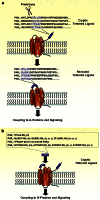Proteinases and signalling: pathophysiological and therapeutic implications via PARs and more
- PMID: 18059329
- PMCID: PMC2268078
- DOI: 10.1038/sj.bjp.0707507
Proteinases and signalling: pathophysiological and therapeutic implications via PARs and more
Abstract
Proteinases like thrombin, trypsin and tissue kallikreins are now known to regulate cell signaling by cleaving and activating a novel family of G-protein-coupled proteinase-activated receptors (PARs 1-4) via exposure of a tethered receptor-triggering ligand. On their own, short synthetic PAR-selective PAR-activating peptides (PAR-APs) mimicking the tethered ligand sequences can activate PARs 1, 2 and 4 and cause physiological responses both in vitro and in vivo. Using the PAR-APs as sentinel probes in vivo, it has been found that PAR activation can affect the vascular, renal, respiratory, gastrointestinal, musculoskeletal and nervous systems (both central and peripheral nervous system) and can promote cancer metastasis and invasion. In general, responses triggered by PARs 1, 2 and 4 are in keeping with an innate immune inflammatory response, ranging from vasodilatation to intestinal inflammation, increased cytokine production and increased or decreased nociception. Further, PARs have been implicated in a number of disease states, including cancer and inflammation of the cardiovascular, respiratory, musculoskeletal, gastrointestinal and nervous systems. In addition to activating PARs, proteinases can cause hormone-like effects by other signalling mechanisms, like growth factor receptor activation, that may be as important as the activation of PARs. We, therefore, propose that the PARs themselves, their activating serine proteinases and their associated signalling pathways can be considered as attractive targets for therapeutic drug development. Thus, proteinases in general must now be considered as 'hormone-like' messengers that can signal either via PARs or other mechanisms.
Figures



References
-
- Adam E, Hansen KK, Astudillo Fernandez O, Coulon L, Bex F, Duhant X, et al. The house dust mite allergen Der p 1, unlike Der p 3, stimulates the expression of interleukin-8 in human airway epithelial cells via a proteinase-activated receptor-2-independent mechanism. J Biol Chem. 2006;281:6910–6923. - PubMed
-
- Ahlquist RP. A study of the adrenotropic receptors. American Journal of Physiology. 1948;153:586–600. - PubMed
-
- Akers IA, Parsons M, Hill MR, Hollenberg MD, Sanjar S, Laurent GJ, et al. Mast cell tryptase stimulates human lung fibroblast proliferation via protease-activated receptor-2. Am J Physiol Lung Cell Mol Physiol. 2000;278:L193–L201. - PubMed
-
- Al-Ani B, Saifeddine M, Hollenberg MD. Detection of functional receptors for the proteinase-activated-receptor-2-activating polypeptide, SLIGRL-NH2, in rat vascular and gastric smooth muscle. Can J Physiol Pharmacol. 1995;73:1203–1207. - PubMed
Publication types
MeSH terms
Substances
LinkOut - more resources
Full Text Sources
Other Literature Sources
Miscellaneous

